March 30, 2018
Air Date: March 30, 2018
FULL SHOW
SEGMENTS
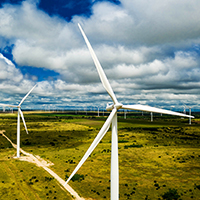
US Gov’t Spending Goes Green
View the page for this story
Billions of dollars in additional funds for scientific research, including renewable energy research, earth systems observations and sea level monitoring were tucked inside the $1.3 trillion omnibus spending measure passed March 23, won by a center-right Republican and center-left Democratic coalition that also defeated efforts to gut funding for the EPA. And most of some 80 anti-environmental riders were dropped before the final vote. But as Washington Reporter Marianne Lavelle of InsideClimate News tells host Steve Curwood, the Trump Administration is still pushing for environmental rollbacks and environmental advocates are staying vigilant. (11:01)
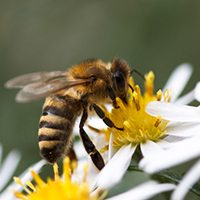
Beyond The Headlines
/ Peter DykstraView the page for this story
This week, Peter Dykstra and host Steve Curwood go beyond the headlines for news of bees, trees, and more trees. They discuss how bees seem to combat a damaging pesticide, the importance of coastal ecosystems in carbon sequestration and a Clinton-era Forest plan that nearly everyone grumbled about. (04:01)
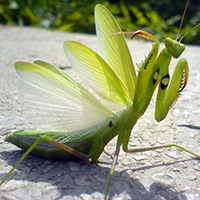
Note on Emerging Science: Fear Itself
/ Noble IngramView the page for this story
The mere whiff of a praying mantis can be enough to scare fruit flies away from food and sex. As Noble Ingram reports in this week’s Note on Emerging Science, the biological drive to give into fear can be just as disastrous as a genuine threat. (02:10)

Coal Plants Damage Infant DNA
View the page for this story
Coal plant emissions can damage health in many ways and new research suggests that they can have direct impacts on genetic fitness. The study from Columbia University found notable differences in the DNA of neonatal babies born before and after a coal plant in China was shut down. Host Steve Curwood spoke with co-authors Dr. Frederica Perera and Dr. Deliang Tang about coal pollution’s effects on long-term physical and cognitive health outcomes. (08:45)
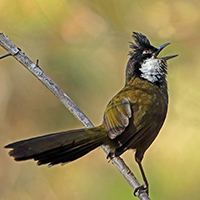
BirdNote®: Australia’s Rainforest Birds
/ Mary McCannView the page for this story
Northeastern Australia’s rainforests are home to a number of some intriguing species, as Mary McCann describes in today’s BirdNote®. (01:59)
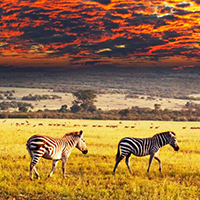
Losing Life on Earth
View the page for this story
A sharp decline in biodiversity is affecting every region of the world, the United Nations reports. A three-year study finds that land degradation is leading to a loss of ecosystem services with profound implications for humanity, putting billions of people at risk of going without adequate food, water, and energy. Host Steve Curwood talks with Sir Robert Watson, chair of the Intergovernmental Science-Policy Platform on Biodiversity and Ecosystem Services, about the report’s scope and possible solutions. (11:22)

Nature and the Beat
/ Bobby BascombView the page for this story
From the chirp of a Katydid to the screech of a parrot, the sounds of nature are all around us and now can be used to help humans make music. Living on Earth’s Bobby Bascomb reports on Beast Box, a website that allows users to create their own unique songs using catchy beats and animal calls as the instruments. (06:49)
Show Credits and Funders
Show Transcript
HOST: Steve Curwood
GUESTS: Marianne Lavelle, Frederica Perera, Deliang Tang, Robert Watson
REPORTERS: Peter Dykstra, Noble Ingram, Bobby Bascomb, Mary McCann
[THEME]
CURWOOD: From Public Radio International, this is Living on Earth.
[THEME]
CURWOOD: I’m Steve Curwood. A stark warning from the UN of growing losses in biological diversity.
WATSON: We are degrading nature and it’s undermining human wellbeing. Our ability to supply food, clean water, energy, it’s not just an environmental issue, it’s also a development issue.
CURWOOD: But the good news is there’s still time to turn things around. Also, adding beats to the soundtrack of nature to create love, joy and conservation.
MIRIN: I hear music in everything. I’m just a messenger for the intricately-tuned voices of the natural world. The fact that nature is always singing is something that is really exciting to me I hope can create similar excitement and joy in others.
[ANIMAL CALLS]
CURWOOD: Beast Box and more this week on Living on Earth – Stick Around!
[NEWSBREAK MUSIC: Boards Of Canada “Zoetrope” from “In A Beautiful Place Out In The Country” (Warp Records 2000)]
[THEME]
US Gov’t Spending Goes Green
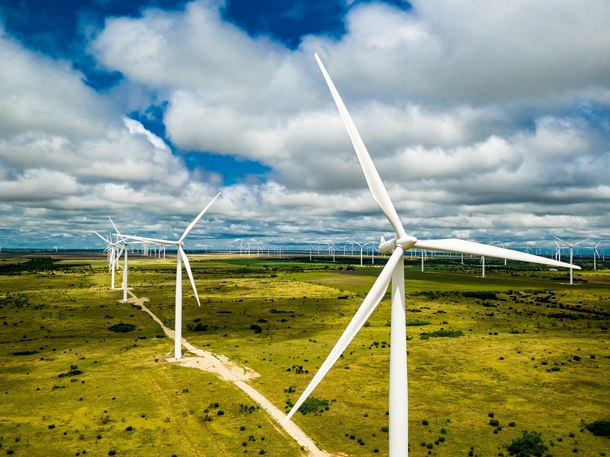
A Texas wind farm. Wind energy is now the second-largest power source in the Lone Star State (after natural gas), and increasingly important for many state economies. While President Trump asked for sharp reductions in renewable energy programs for the 2018 appropriations bill, a bi-partisan deal crafted in Congress increased funding for renewable energy. (Photo: Davis, Flickr CC BY-ND 2.0)
CURWOOD From PRI, and the Jennifer and Ted Stanley Studios at the University of Massachusetts, Boston, this is Living on Earth. I’m Steve Curwood. Folks at agencies from the EPA to NOAA to the eight regional climate information centers of the US Geological Survey, are now breathing sighs of relief as they will keep their federal funding or even see increases, thanks to a bipartisan federal spending measure enacted March 23rd. A coalition of center-right Republicans and center-left Democrats voted to boost a cap on defense and domestic spending, making room for more funding for everything from fighter planes to renewable energy research. The vote also stripped most of the anti-environmental measures known as riders. Here to tell us more is Marianne Lavelle, Washington reporter for InsideClimate News. Marianne, welcome back to Living on Earth!
LAVELLE: Glad to be here, Steve.
CURWOOD: So, there's a lot of good news here in this budget for people concerned about science, the environment, stuff like climate change. Let's talk about some of these. What about the Geological Survey's climate centers? How did they do?
LAVELLE: Right, well the Trump administration had wanted to get rid of about half of them, and I think they're all staying. That's really important because the USGS has done some of the really important study on sea level rise and its impact on the coasts, so that was important in a lot of states.
CURWOOD: Now, before all of this, the EPA was going to walk the plank almost to oblivion. What happened finally?
LAVELLE: Right, right. They were looking at a 30 percent cut in their budget, and that would take them back to, oh, about the Reagan administration level of cutting. They already have lost 700 people through buyouts, and they were looking at losing 2,000 more. Well, Congress said no to that and kept them at their current budget. So, they have fewer employees than they did at the beginning of the Trump administration, but it could have been a lot worse.

The Environmental Protection Agency’s headquarters in Washington, D.C. The spending bill retains EPA’s budget at the same level as 2017, despite President Trump’s request to cut the agency’s funding by 30%. (Photo: Coolcaesar, Wikimedia Commons CC BY-SA 3.0)
CURWOOD: And talk to me about the Department of Energy and how they fared in this - in this financial arrangement?
LAVELLE: Yes, things like the Office of Renewable Energy and Energy Efficiency. That office was going to see a 70 percent cut under the Trump plan, and actually it gets an increase – not just a small increase, a pretty large one – nearly a 13 percent increase. And this really is testimony to how important clean energy has become in red states. Texas now is the number one wind energy state, Iowa, very big wind energy state, Kansas, even Oklahoma, is looking forward to expanding wind energy and bringing the tech industry there because the tech industry wants to have renewable energy.
So, all of these states, whether you're a red state or a blue state, new technologies and wind and solar energy has become an important business. In particular, look at the program called ARPA-E, Advanced Research Programs Agency-Energy. The Defense Department has a similar program but it's to really seed early stage development in clean energy, and there are programs all over the country on this, and the Trump administration wanted to eliminate that program. They said the private sector should be doing this sort of research. Well, of course, the private sector does not invest in early-state research, and Congress felt this was a really important thing to continue to invest in. They increased that budget 15 percent. And the thing to remember is that DARPA, the Defense Advanced Research Projects Agency, that's where the Internet really was born. So, the government has a pretty good track record of results for this early stage research.
CURWOOD: Now, what about NOAA? There's a fair amount of climate research that's been done in the National Oceanic and Atmospheric Administration. I guess they got a fair amount of an increase, huh?

Some Republican lawmakers tried to include riders blocking enforcement of the Endangered Species Act. One rider sought to block federal protection of the Greater Sage-Grouse, a species that’s threatened by oil and gas development in its sagebrush habitat. (Photo: Jeannie Stafford/USFWS, Flickr CC BY 2.0)
LAVELLE: Right. Again NOAA was looking at a one billion dollar cut and NOAA's budget also increased. NOAA, it's hard to overstate how important they are to these coastal communities in the research they do. For example, the sea grants that were going to be eliminated by the White House. Well, they're very important for the future of fisheries on the Atlantic Coast, the Gulf Coast. They have even been doing research into how to predict heat waves and such in the ocean just as they predict weather, so that fisheries can prepare for the changes that they're seeing on a much more frequent basis now that we are facing climate change and what Congress did was NOAA shows how important this is to their constituents, whether Republican or Democrat.
CURWOOD: Now, there's a flip side to the spending bill. It took out all kinds of what are known as "riders" that a number of folks considered to be anti-environmental. Talk to me about some of those that didn't make it in.
LAVELLE: Right, in the drafts of the budget there were about 80 anti-environmental riders as well as some riders that would have very radically changed campaign finance law, which also was very troubling to environmental advocates. Most of those riders were eliminated by the GOP leaders. They really needed to do that in order to get the Democratic votes that they needed to pass this budget.
CURWOOD: Talk to me about some of those riders that got knocked out.
LAVELLE: There were many endangered species riders. One of them would have prevented regulation around the Sage-grouse, which is a big showy bird in the west, but the important thing about that bird is it's kind of a marker for the whole sagebrush ecosystem and about a hundred other species, and the Obama administration had done kind of this middle of the road thing with the Sage-Grouse. They came up with this – they called the Cooperative Conservation Plan. They felt that with the states involved, that they could work out a deal to protect the sagebrush and allow oil and gas development to continue. Well, the oil and gas industry very much did not want any of that regulation, and that is what the rider in Congress would have done. That rider was eliminated. But, it's important to know that the Trump administration is going forward with trying to undo the deal that Obama cut on the Sage-Grouse. That's happening with a lot of these riders.
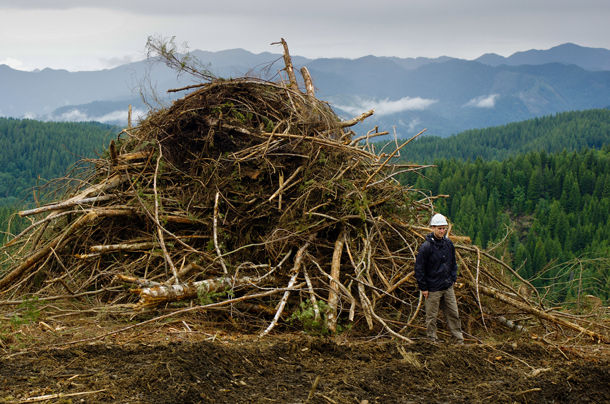
Proponents of biomass energy say that forest regrowth will theoretically suck carbon dioxide back out of the atmosphere after trees are burned for energy, making biomass energy carbon-neutral. But forest experts point out that it will take decades or even a century to reach carbon neutrality. (Photo: Oregon Department of Forestry, Flickr CC BY 2.0)
CURWOOD: Talk to me about the methane rule rider, which I guess was ultimately rejected by Congress. This was a pretty big deal, right?
LAVELLE: It's a really big deal. Next to the Clean Power Plan, it's one of the biggest steps that the Obama administration took on climate change was several rules really to do with methane. And the Obama administration looked at this as an easy thing to do on climate because all you're really doing is preventing leaks in the pipes and in the infrastructure, just some new monitoring requirements, some better wrenches and pipes. Well, so one of the first things that the Trump administration set out to do was to get rid of methane regulations. They have tried to do that in many different ways. They've been knocked back by the courts. They were unable to get the votes in the Senate last May to do it. And this budget bill showed they were not able to get it through as a add-on to the budget as well. Now, Secretary of Interior Ryan Zinke is continuing his effort to go through the whole rulemaking process to get rid of those methane regulations. So, that is still – that’s the thing about this victory on the riders for the environmentalists. Although they have won this battle, the war is not over because in almost every case the Trump administration is going forward on a whole variety of fronts to undo these regulations.
CURWOOD: Now, let's talk about one of the few anti-environmental provisions that did make it in this spending bill. I understand one of them encourages burning biomass, typically small, scraggly trees for electric generation. Now, what's wrong with that from an environmental perspective?
LAVELLE: Right. Well there are two concerns that environmentalists have. One, is the pollution – particularly particulate pollution from that burning of biomass if it is not properly controlled. The other is that the advantages that this bill gives to biomass could make wind energy and solar energy disadvantaged in the market because it will be cheaper in some places to just burn biomass, and it won't be as beneficial for the environment, it won't be as beneficial for climate because burning wood and biomass puts carbon into the atmosphere. So, that is kind of the two-fold environmental concern about that.
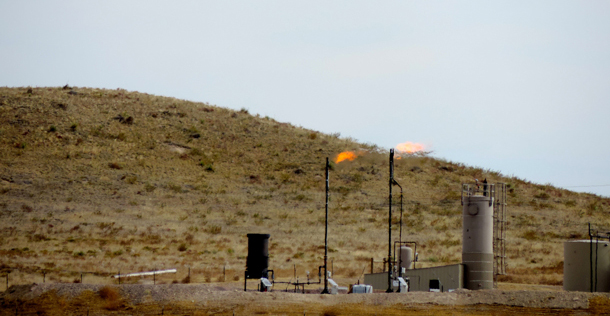
Methane flaring wastes precious natural gas resources, and leaked methane is a major contributor to climate change, the Obama Administration said when it created a rule governing methane leaks and flaring on public lands. A rider that did not survive final negotiations for the FY 2018 federal appropriations bill would have rolled back the rule. (Photo: WildEarth Guardians, Flickr CC BY-NC-ND 2.0)
CURWOOD: But the argument was made, “Look, all right so you burn the tree and the carbon goes into the atmosphere but then more trees grow, so it comes back.”
LAVELLE: So it's a renewable resource. Unfortunately, the way that it is practiced is that we burn it much more quickly than we grow the trees to replace that biomass.
CURWOOD: So, what's the mood in the environmental lobby now and in Washington after this budget has passed?
LAVELLE: Eternal vigilance seems to be the mood in the environmental community. I would say there was a brief sigh of relief followed by more determination to keep up with what the Trump administration is doing, especially when it comes to climate change.
CURWOOD: Marianne Lavelle writes politics for InsideClimate News in the Washington area. Marianne, thanks so much for taking the time with us today.
LAVELLE: Thanks so much for having me, Steve.
Related links:
- InsideClimate News: “$1.3 Trillion Omnibus Spending Bill Passes After GOP Drops Anti-Environment Riders”
- Science Magazine: “Trump, Congress approve largest U.S. research spending increase in a decade”
- InsideClimate News: “GOP Pushes 80 Anti-Environment Riders, Dark Money Rule Changes in Spending Bill”
- About the ARPA-E program
- NOAA’s Climate arm
- USGS National Assessment of Coastal Vulnerability to Sea Level Rise
- Scientific American: “Congress Says Biomass Is Carbon-Neutral, but Scientists Disagree”
- U.S. Fish & Wildlife Service: About the Greater Sage-Grouse
- High Country News: Commentary on Secretary Zinke’s attempts to roll back the Methane Rule
[MUSIC: San Francisco String Trio, “When I’m Sixty-Four” on May I Introduce to You, John Lennon and Paul McCartney, Ridgeway Records]
CURWOOD: Your comments on our program are always welcome. Call our listener line any time at 617-287-4121, that’s 617-287-4121. Our email address is comments at loe dot org, and visit our webpage at loe dot org. That’s loe dot org. Coming up, how some bees seem to outsmart a pesticide. That’s just ahead – keep listening to Living on Earth!
ANNOUNCER: Support for Living on Earth comes from the Gordon and Betty Moore Foundation, and from a friend of Sailors for the Sea, working with boaters to restore ocean health.
[CUTAWAY MUSIC: San Francisco String Trio, “When I’m Sixty-Four” on May I Introduce to You, John Lennon and Paul McCartney, Ridgeway Records]
Beyond The Headlines
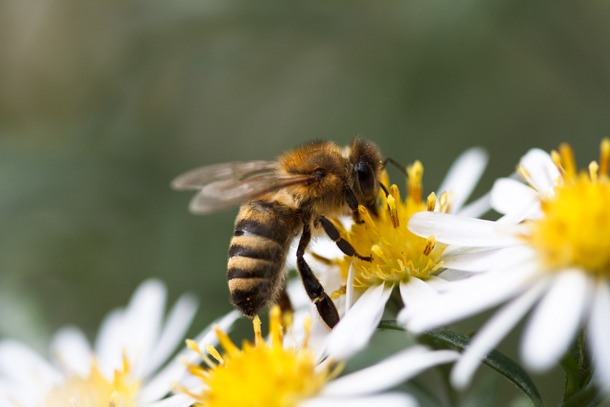
A new study finds that bees can break down certain pesticides. (Photo: Pimthida, Flickr CC BY-NC-ND 2.0)
CURWOOD: It’s Living on Earth, I’m Steve Curwood. Time to check in with Peter Dykstra beyond the headlines now. Peter’s an editor with DailyClimate dot org and Environmental Health News, that’s ehn.org, and he’s on the line from Atlanta, Georgia. Hey, it must be spring down there, Peter?
DYKSTRA: Yeah, spring, it’s a little chilly today. But it’s that time of year when you get to see that bees come out and pollinating blueberry bushes and things like that. But let’s talk about bees for a minute. Around the world bee populations are plummeting, and the cause for bees decline, well, one is parasites, another one is habitat loss; a third one are pesticides, particularly neonicotinoids. Now there’s a study out that says that enzymes within some bees can prevent the damage from neonicotinoids, particularly a kind of chemical called thiacloprid. Say that fast, “neonicotinoid, thiacloprid.” And that particular chemical is going to potentially lead to new research that will tailor-make other chemicals that will cause less harm to bees and less harm to the environment in general.
CURWOOD: So you’re telling me that bees are giving these chemicals the bees-iness, huh?
DYKSTRA: They’re giving them the bees-iness. And it looks like something that may allow some certain chemical pesticides and bee populations and pollinators to live together.
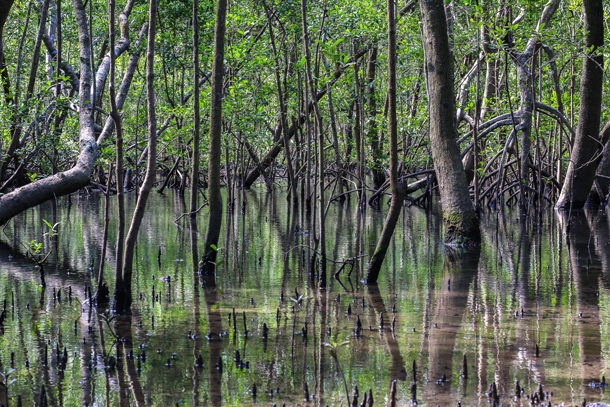
So-called “blue carbon” habitats, like mangroves and tidal wetlands, can sequester much more carbon than “green carbon” dry land forests. (Photo: Marcia Motta, Flickr CC BY 2.0)
CURWOOD: Well that would be great news. So what else do you have for us today?
DYKSTRA: Well let’s go from bees to trees. We know that trees are our friends in terms of CO2, they bring in CO2, send out oxygen. But there’s a source of CO2 sink out in the world that’s much, much bigger that we rarely talk about. That’s called the blue carbon areas. Like mangrove swamps, coastal wetlands. They can consume as much as 40 times the CO2, and hold on to it, as trees do. And the problem is that both trees and blue carbon areas are under assault.
CURWOOD: Yeah, and as I understand it, if the carbon goes into a tree, Peter, right – that it stays there as long as the tree’s around, but then often the tree gets burned or something goes back in the atmosphere. But if it goes in these mangroves and tidal wetlands, it just keeps building and building and building and, you know, after a period of time it might be coal, or something like that.
DYKSTRA: It could turn into fossil fuels over hundreds of thousands, millions of years. But also, if those wetlands and mangrove swamps are destroyed a huge amount of CO2 can go up. Just like we now see CO2 rising from melting permafrost in the Arctic.
CURWOOD: Yeah, that’s not great. Hey, Peter, what do you have from the history vault this week?
DYKSTRA: Well let’s stick with trees, and go back twenty-five years to late March, 1993. There was a huge uproar, particularly in the Pacific Northwest, between loggers and environmentalists. President Clinton and Vice President Gore called a Forest Summit. They came up with a Northwest Forest Plan to help protect endangered animals like the Northern Spotted Owl, and also give the logging industry some opportunity to cut in old growth forests. They came up with this plan and…everybody hated it.
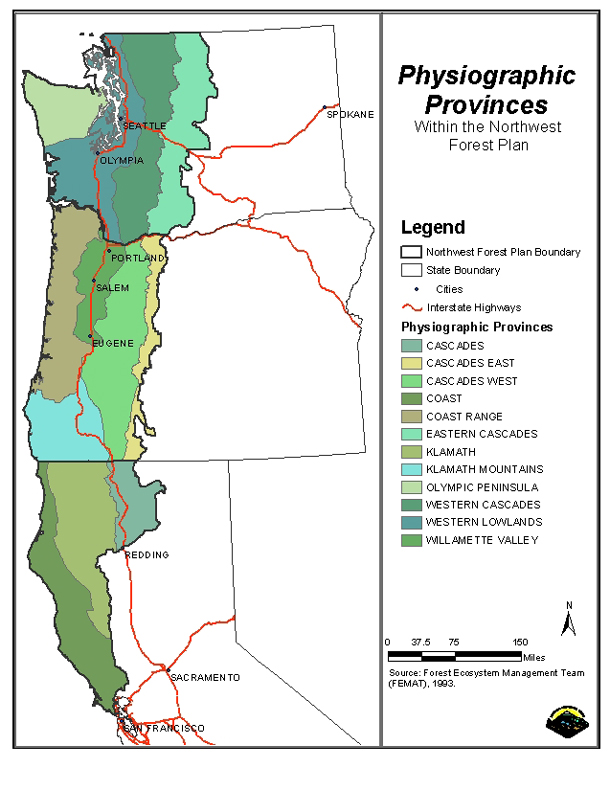
The 1993 Northwest Forest Plan included parts of northern California, Oregon, and Washington State. (Photo: US Forest Service Regional Ecosystem Office)
CURWOOD: Yeah [LAUGHS] and I think people started suing each other, and maybe they’re even suing each other today, still.
DYKSTRA: Yeah, the loggers never reached their quota. The environmentalists thought that too much was being cut. And that kind of ill will has continued to this day, twenty-five years later.
CURWOOD: Hey Peter, before you go, there’s something I need to bring up.
DYKSTRA: Go ahead.
CURWOOD: Well, last week when we were talking I said that Norway has half of its cars as electric. I actually should have said that half of the cars being sold today in Norway are electric or hybrid electric.
DYKSTRA: Thanks for the correction, but you’ll never work in this town again, Curwood.
CURWOOD: [LAUGHS] Peter Dysktra is an editor with Environmental Health News, that’s EHN.org, and DailyClimate.org. Thanks so much, Peter. Maybe we’ll talk to you again real soon.
DYKSTRA: Uh, maybe talk to you soon Steve.
CURWOOD: And there’s more on these stories at LOE.org.
Related links:
- Australian Broadcasting Corporation: “Threatened blue carbon ecosystems store carbon 40 times faster than forests”
- Science News: “How bees defend against some controversial insecticides”
- Read a summary of the 1993 Forest Summit
- Updated information on the Northwest Forest Plan
- Environmental Health News
- The Daily Climate
[MUSIC: Daisycutter, “Johnny Appleseed” on Waiting For the Stars, composed by Joe Strummer/Martin Slattery/Scott Shields/Pablo Cook/Tymon Dogg, Loonymusik]
Note on Emerging Science: Fear Itself
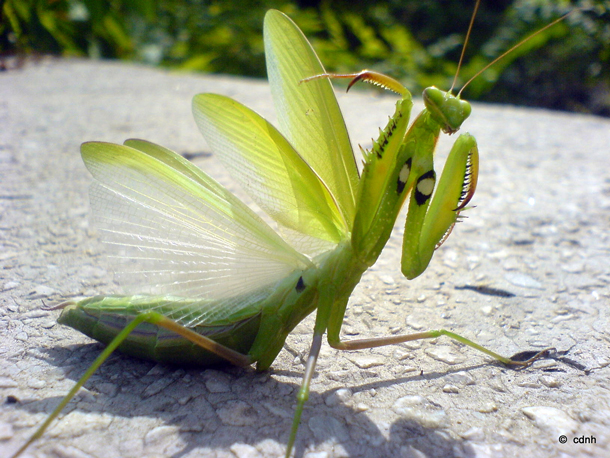
Predators like this praying mantis can be threats to others without directly harming the prey – they just need to be scary. (Photo: cdnh, Flickr CC-BY-SA 2.0)
CURWOOD: In a minute, how cutting pollution from a coal plant can actually change DNA in babies – but first this note on emerging science from Noble Ingram.
[MUSIC: SCIENCE NOTE THEME]
INGRAM: For President Franklin Delano Roosevelt, in 1933, the hardscrabble path out of the Great Depression had but one roadblock.
ROOSEVELT: Let me assert my firm belief that the only thing we have to fear is … fear itself!
INGRAM: Today, scientists from McGill University and the University of Guelph in Canada have found that what was true 85 years ago may also be true today. The researchers discovered that indications of a lurking predator can cause some fruit flies to abandon behaviors critical to their survival. FDR had a point; fear itself can be deadly.
The team exposed small groups of the tiny insects to the scent of a hungry praying mantis. Alerted to nearby danger, the flies avoided activities like eating and reproducing, which would leave them vulnerable. After the initial puff of mantid perfume, the risk of a total die-off increased seven-fold.
As it turns out, the size of these isolated populations played a critical role. Fruit flies compete for resources and in large numbers, suffer from excess competition. But the team found that smaller, otherwise-unstressed populations actually suffered more from fear than larger groups. When all other environmental factors encouraged these flies to eat and breed freely, the creeping sense of danger interfered.
This curious biological phenomenon is known as the Allee effect and it poses serious problems for struggling species, especially social animals like meerkats or starlings. As the saying goes, there’s safety in numbers, and it’s possible that for many prey animals, the fear that comes with losing your network is just as dangerous as the reality of a predator. Having no one to keep a lookout -- even if nothing is really there -- can spell disaster.
So in times of uncertainty, remember what FDR said, and keep your friends close -- even if only for the peace of mind.
That’s this week’s Note on Emerging Science. I’m Noble Ingram.
[MUSIC: SCIENCE NOTE THEME]
Related links:
- The original study in Proceedings of the Royal Society B: Biological Sciences
- ScienceDaily: “How fear alone can cause animal extinction”
Coal Plants Damage Infant DNA

China has relied on coal to carry it through its rapid industrialization, but some plants are shutting down as China makes moves toward renewable energy. (Photo: Azchael, Flickr CC BY-NC 2.0)
CURWOOD: Pollution from coal plants has been linked to adverse health effects, including increased risk of cardiovascular problems and shortened life spans, and a new study suggests a reason why. Telomeres are protective tips at the end of each string of DNA, and if they shrink they make it harder for cells to reproduce properly. And it’s known that shorter telomeres are linked to aging. Now researchers at the Columbia University Mailman School of Public Health have found that babies born near a coal plant in China had shorter telomeres than those born in the same place after the plant was shut down. Two of those researchers from the Mailman School – Professors Frederica Perera and Deliang Tang join us now from New York to discuss their findings – welcome to Living on Earth!
PERERA: Thank you very much.
TANG: Thank you.
CURWOOD: So, perhaps, Dr. Perera, you could explain the function of telomeres. What are the health effects related to shorter than average telomere lengths?
PERERA: Well, telomeres these repeated sequences of DNA that form a kind of cap on the ends of chromosomes, and they preserve the integrity of those chromosomes, and that's very important because it's been seen that, mostly in adults, that shorter telomeres are associated with cardiovascular illness, premature aging, cognitive decline and certain cancers. So, you want to have longer telomeres.

The human chromosomes are pictured in blue, while the white points at the ends of the chromosomes are telomeres. (Photo: NIH image gallery, Flickr CC BY-NC 2.0)
CURWOOD: So, longer life, longer telomeres.
PERERA: Yes, and that's why we use this particular biologic marker in this study in China because we could use it to see whether this was an additional benefit of the closure of a polluting coal plant.
CURWOOD: So, your study looked at blood from umbilical cords, pregnancies that – some occurred while the coal plant was operating, some occurred afterwards. What were the differences you found?
PERERA: There were many differences actually, and we, over the years, have been able to show that there were many benefits and this is just the latest one. The first thing we found was that the levels of this pollutant polycyclic aromatic hydrocarbons – PAH for short – latched on to DNA were much lower in the second cohort. That's a good sign, less exposure. We also found that levels of a protein involved in early brain development called BDNF were much higher significantly so, and so here's the third short of chapter in this story where we looked at this novel biomarker called telomere, and asked the same question. Is there a difference? Do we see longer telomeres after the plant was shut down, meaning those babies did not have prenatal exposure to these particular combustion byproducts, and was the air pollution associated with shorter telomeres? And the answers to both of those questions were yes.
CURWOOD: Dr. Tang, so you found this difference. What does this difference mean for the outcome of the children?
TANG: At age two, we did another neural assessment. The difference between two cohorts is not statistically significant, but is showing there are some of the same trend. After the power plant was shut down, our air motoring data is showing significant reduction in terms of the air concentration of the PAHs. The reduce of the air pollution well improved the children's health in different ways in terms of the physical development also in the neural development too. A lot of those neural development issues, it's not reversible.

Frederica Perera is professor of Environmental Health Sciences and the Director of the Columbia Center for Children’s Environmental Health at Columbia University’s Mailman School of Public Health. (Photo: Columbia University)
CURWOOD: Dr. Tang, is there any way to quantify the value of shutting down this coal plant in terms of what it does to enhance human health?
TANG: We didn't quantify the health costs and another similar studies in China, we published two years earlier that we do a quantify the reduction of the pollution, what is the economic impact on the municipality in terms of the health costs which is very very significant. There is a perception saying that, oh, reduce environmental pollution may have a negative impact on the local economics. And actually, our evidence focused on the health costs alone, showing there is a tremendous improvement in terms of economic situation.
PERERA: I would add, may I add one thought, that in that analysis we didn't really talk much about the benefits to children from reducing pollution and that's something we're going to do more and more now based on results in this study and others we think that we can document the full spectrum of benefits, including to children's health and their long term health and functioning over their whole lifetimes and monetize those along with the conventional adult diseases and costs avoided there.
CURWOOD: It sounds like what you're saying that move out the coal plants and you have a smarter population?
PERERA: It looks that way. Less fossil fuel burning, cleaner air, smarter babies, healthier babies, healthier children and better life course health. So, yes I think there's good news. I should mention that this is the first study of telomeres in newborns. There have been studies in workers with exposures to specific chemicals, pesticides and a few very few studies in children but this is the first look into that very early window in cord blood when babies are first born.
CURWOOD: Dr. Tang, how has the government of China responded to your research?
TANG: We are very proud to be one of the very few environmental studies in China. The four environmental study teams operating in China are successful, and our study designs a way to document the effectiveness of the government policy and it brings the good news to the society. And also at this moment, China you know, facing a big challenge nationwide dealing with environmental health issues, and they are citing study cases as proof, and it's a hope to many other cities in China. As long as we're committed, the pollution can be reduced and the population health can be improved.

Deliang Tang is an associate professor of Environmental Health Sciences at the Mailman School of Public Health. (Photo: Columbia University)
CURWOOD: Dr. Perera, how has the United States government ... I'm thinking particularly the EPA, how have they responded to your research?
PERERA: Well, we haven't heard anything about this particular article, but in the past the government both at the federal level, as well as state and local levels have been very receptive to this information, and we've had a letter from Mayor Bloomberg in the past thanking us for our data that prompted more congestion relief in the city and other policies to reduce air pollution. We've testified before Congress and before legislators at the state level so there's been great receptivity. And I would hope that they'll be more of that in the future, so that science can actually inform and improve policymaking.
CURWOOD: Well, I want to thank you for this research. I mean, intuitively you would think one would be healthier for not breathing air that's belched out of a smokestack of a coal fire power plant, but scientific evidence is important in these discussions.
PERERA: Absolutely, and no city in the world is free of these particular pollutants. Coal is obviously a big source in certain countries, but oil burning, even burning of natural gas, any kind of fossil fuel burning does release these pollutants along with fine particles and metals, a whole bunch of other toxic pollutants, and CO2 which is a main driver of climate change.
So, when you take all this evidence together including the telomeres, the implication here is that children are going to experience reduced risk of disease including premature aging. It's a good news story. It's a bit different from what we've done up to now, which is usually to tell the bad news to document these associations between pollution and adverse health effects in the children later on. So, here we had a nice opportunity to show good news and benefits of an intervention that the government did when they shut this plant down.
CURWOOD: Dr. Frederica Perera and Deliang Tang are professors at the Columbia University Mailman School of Public Health. Thank you for taking the time with me today.
TANG: Thank you, Steve.
PERERA: Thank you very much Steve. Pleasure.
Related links:
- The study on telomere length and air pollution, published in the journal Environmental International
- Frederica Perera’s Faculty Bio
- Deliang Tang’s Faculty Bio
BirdNote®: Australia’s Rainforest Birds
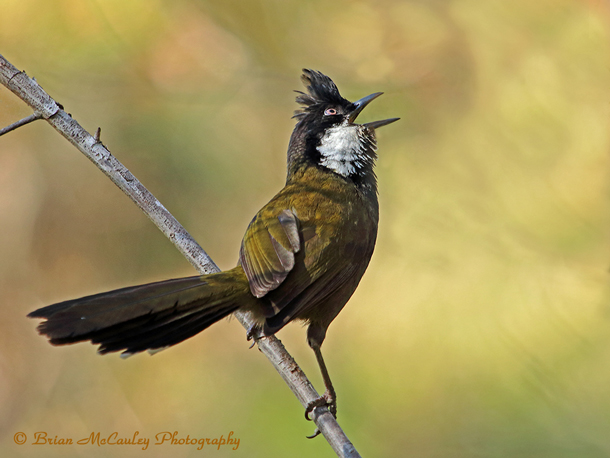
An Eastern Whipbird, which lives primarily in the understory of the Australian rainforest. (Photo: Brian McCauley)
[MUSIC: BIRDNOTE® THEME]
CURWOOD: A visit to a far-off country can offer the chance to experience the truly exotic and unfamiliar – and as Mary McCann tells us in today’s BirdNote, that’s certainly true of the land down-under.
BirdNote®
Australia’s Rainforest Birds
[http://macaulaylibrary.org/audio/193295, 0.02-.05]
MCCANN: The rainforests of Northeastern Australia are isolated from all other rainforests on earth. As a result, they harbor many species of birds found nowhere else.
[http://macaulaylibrary.org/audio/193295, 0.02-.05]
The Eastern Whipbird hangs out in the dense understory. It’s dark, crested, 10 inches long—and more often heard than seen. Like its neighbor, the Spotted Catbird, that’s nearly a foot long and emerald-green with white spots.
[http://macaulaylibrary.org/audio/202015, 0.37-.42]
Easier to lay eyes on is the large, pigeon-like Wompoo Fruit-Dove, perching high in a tree, gulping down small fruits. Feathered in a stunning combination of green, purple, and yellow, this bird is clearly named for its voice.
[http://macaulaylibrary.org/audio/202015, 0.37-.38]
While pig-like grunting on the forest floor tells us we’re in the company of the largest bird on the continent—the Southern Cassowary.
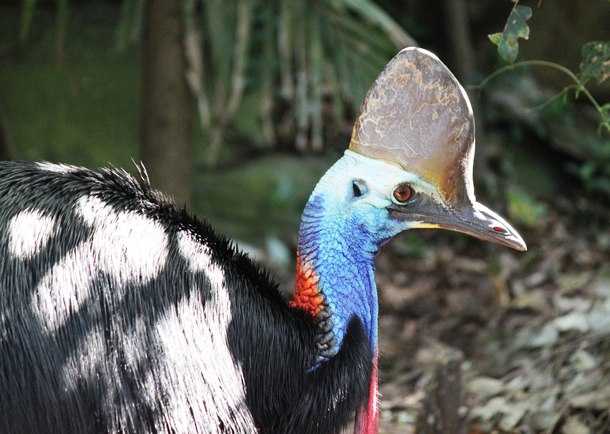
A Southern Cassowary, the largest bird found on the Australian continent. (Photo: OZinOH)
[http://www.xeno-canto.org/species/Casuarius-casuarius]
On average, the female weighs 130 pounds and stands around 5 feet tall, looking like a giant, lush, black hairpiece on thick legs.
[http://www.xeno-canto.org/species/Casuarius-casuarius]
A helmet called a casque makes it look as much like a dinosaur as any living bird.
[http://www.xeno-canto.org/species/Casuarius-casuarius, first recording in list]
I’m Mary McCann.
###
Written by Bob Sundstrom
Bird sounds provided by The Macaulay Library of Natural Sounds at the Cornell Lab of Ornithology, Ithaca, New York: Eastern Whipbird [193295] recorded by David A McCartt; Spotted Catbird [189064] recorded by Cedar A Mathers-Winn; Wompoo Fruit-Dove [202015] recorded by Emma I Greig.
Southern Cassowary recorded by Marc Anderson, sourced from
http://www.xeno-canto.org/species/Casuarius-casuarius
Producer: John Kessler
Executive Producer: Dominic Black
© 2005-2018 Tune In to Nature.org March 2018 Narrator: Mary McCann
http://birdnote.org/show/australias-rainforest-birds
CURWOOD: Burrow on down to our website, loe dot org, to see some photos and learn more.
Related links:
- This story on the BirdNote® website
- The call of the Eastern Whipbird
- The call of the Wompoo Fruit-Dove
- About the Southern Cassowary
[MUSIC: William Barton and the Australian Youth Orchestra/Christoph Eschenbach, “Sculthorpe Earth Cry” not commercially available, composed by William Barton]
CURWOOD: Coming up, how humans and animals can make music together. That’s just ahead here on Living on Earth, stay tuned.
ANNOUNCER: Funding for Living on Earth comes from you our listeners, and United Technologies – combining passion for science with engineering to create solutions designed for sustainability in aerospace, building industries and food refrigeration. UTC companies such as Otis, Carrier, Pratt & Whitney and UTC Aerospace Systems are helping to move the world forward. You can learn more about United Technologies by tuning in to the Race to 9 Billion podcast, hosted by UTC’s Chief Sustainability Officer. Listen at raceto9billion.com. That’s raceto9billion.com. This is PRI, Public Radio International.
[CUTAWAY MUSIC: William Barton and the Australian Youth Orchestra/Christoph Eschenbach, “Sculthorpe Earth Cry” not commercially available, composed by William Barton]
Losing Life on Earth
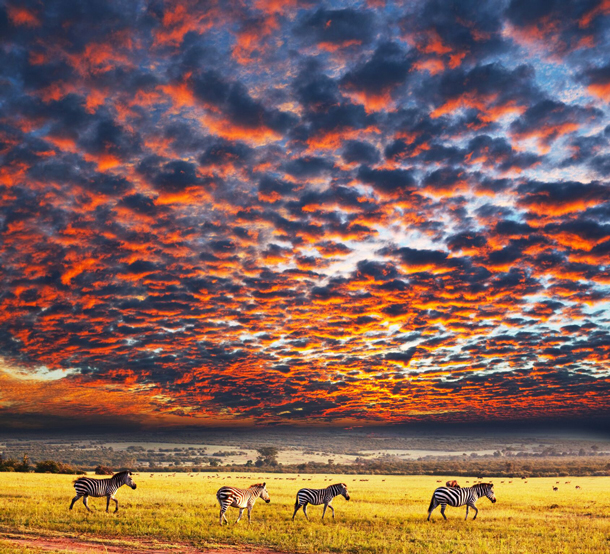
The UN’s IPBES report looked at biodiversity issues in every region of the world. (Photo: Galyna Andrushko/Shutterstock.com)
CURWOOD: It’s Living on Earth, I’m Steve Curwood. The last male Northern White Rhino recently died, and with just two females left alive, the species is functionally extinct. But that loss is just a tiny part of rapidly declining biological diversity according to a new report from the United Nations. It’s the result of three years study and four regional assessments that cover the whole globe, and tries to explain why biodiversity is important, documents the main threats and suggests paths to a more sustainable future. Sir Robert Watson is the chair of the Intergovernmental Science-Policy Platform on Biodiversity and Ecosystem Services, which put the report together, and he joins me now. Welcome to Living on Earth!
WATSON: Thank you very much.
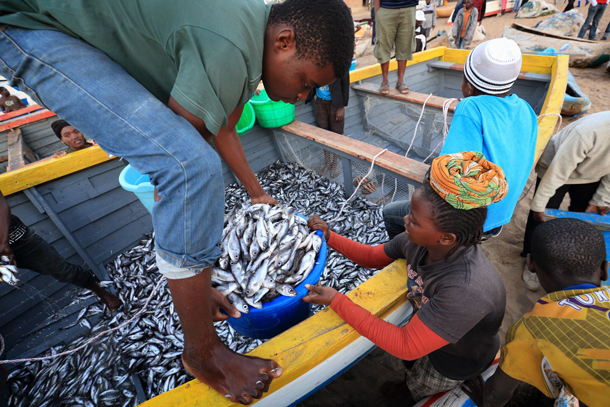
The UN’s IPBES report finds that food security will be a critical issue particularly in developing countries as ecosystems are degraded. (Photo: Dietmar Temps/Shutterstock.com)
CURWOOD: So, from all of your meetings and all these reports, what's the one thing that we need to know right now?
WATSON: The one thing the world needs to know is that we are degrading nature and it's undermining human wellbeing. Our ability to supply food, clean water, energy, and so as we continue to degrade our environment, it's not just an environmental issue, it's also a development issue.
CURWOOD: So, how serious is the scale of biodiversity loss right now as you detailed in this latest report?
WATSON: It's significant. We're losing species at an unsustainable rate, more than 1,000 times the natural rights of evolution. We are degrading our forests across the world, our coral reefs are degrading, our mangrove swamps. So, we're losing species. We're losing not only certain species that may go extinct, but the populations of species are going down. So, if you're in America and you walk through our forests today, it would have actually 30 percent fewer butterflies, birds, animals, plants, and by 2050 it would be 40 percent less. So, we really are changing our ecosystems quite substantially.
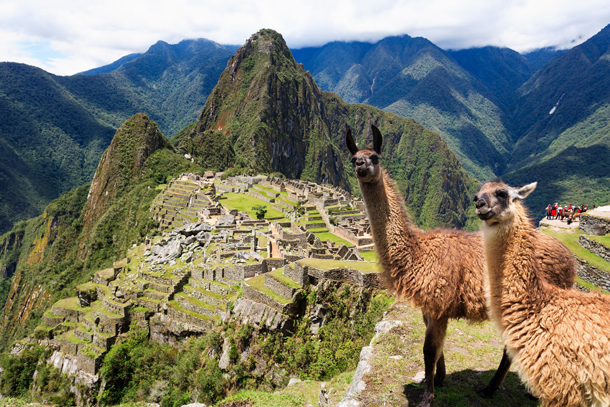
Urubamba Province, Machupicchu District, Peru. (Photo: Marnix Foeken/Shutterstock.com)
CURWOOD: Now, as I understand the report, it was really a study of studies. Tell me a bit about its scope.
WATSON: Yes, we've done actually five studies here, four regional, subregional. So, the Americas and the subregions within the Americas, Asia and the Pacific, Africa and Europe and Central Asia. So, we looked right across the issues from a regional, subregional, and we did the global assessment on land degradation.
CURWOOD: Now, of course humans are but one species among the literally millions on this planet, but why is the loss of biodiversity so concerning to people at this point?
WATSON: If we lose biodiversity and we degrade our ecosystem, we're degrading our soils, we're polluting our waters and therefore as you do degrade soils, as you pollute the waters, it makes it harder to have food security, harder to have water security, as we degrade the land, you get effects in the ocean, our rivers are polluted, our lakes are polluted, the coastal zones are polluted, which again affects freshwater fish, coastal fish, etc. So, as we degrade our natural world, we actually have impacts on what many people really need: food, water.
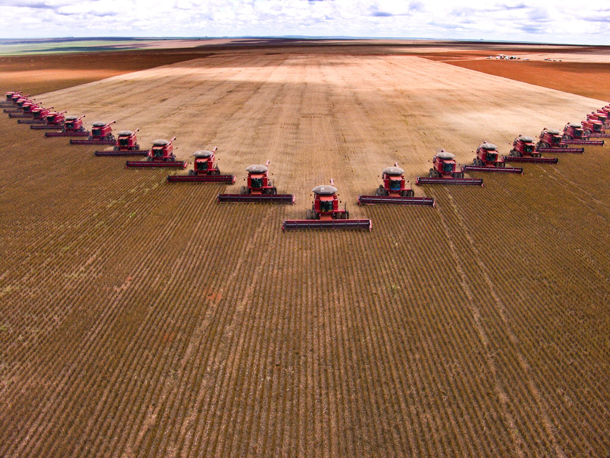
A soybean plantation in Mato Grosso, Brazil was once part of the Amazon rainforest, one of the richest biological regions on earth. (Photo: Alf Ribeiro/Shutterstock.com)
CURWOOD: Now, so what are the driving forces of biodiversity loss these days?
WATSON: The big one today all over the world is the land use change. We've converted our forests, our grasslands, our mangrove systems into agricultural fields, which we've needed, of course, for the food that we need. So, land use change is the major change, and unfortunately when we've converted our land into agricultural systems, many of those aren't sustainable. We're producing more food, but we've got heavy use of chemicals, sometimes overuse of chemicals in many parts of the world, so that's leading to degrading our soils. Those chemicals leach into the rivers. That's affecting our freshwater systems, rivers and lakes.
So, land use change is the biggest, but also there is straight pollution of our ecosystems. There's invasive alien species and a threat that is already emerged, but will only become even more important in time is climate change, and in fact what we've said is land use change is the biggest threat to date, but by 2050, in most ecosystems around the world, climate change will be an equally important threat. Therefore, we have to look at climate change and biodiversity together. They are both environmental, social, economic and development issues.
CURWOOD: I want to ask you about one particular area that your organization has looked at, and that's the loss of pollinators. What's going on there?
WATSON: Yes, we issued a report about a year ago on pollinators, and it's quite clear that wild pollinators are decreasing in many parts of the world. And what we're trying to look at is why might that be. Could it be possibly that we are using too many chemicals, especially things like pesticides, neonicotinoids? With managed honeybees – which is very important to complement the wild bees – were the beehives healthy, as we degraded our natural ecosystems, were there flowery areas amongst the monocultures of agriculture? So, we looked to see to what degree pollinators were being lost, to what degree did pollination services affect food production, and we talked about the various possibilities of how we might sort of halt the decline of pollinators and hopefully even reverse them. So, pollination is crucial to indeed food production, and that was a report we issued about a year ago.
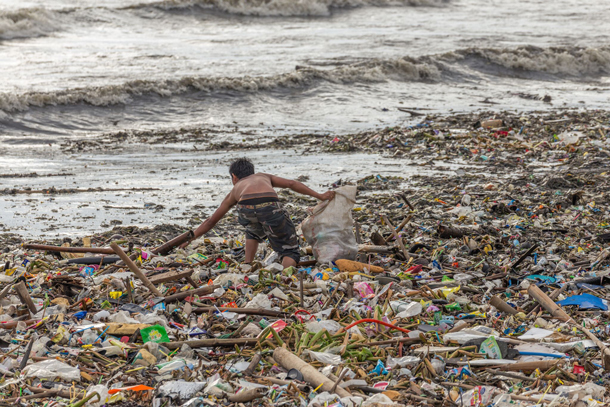
Land degradation is causing a rapid decline in biodiversity and making it difficult for communities that depend on a healthy environment to make their living. (Photo: szefei/Shutterstock.com)
CURWOOD: What's the relationship between biodiversity loss and population growth, do you think?
WATSON: Well, there's no question, two major factors. The more people we have on the Earth and the richer they are, the more they can demand resources. There's more demand for food, more demand for water, more demand for energy. So, indeed it's the combination of numbers of people and the ability to purchase. So, there's no question the threats on the Earth today are far more than, say, 50 years ago and in 50 years time, there will even be more threats. So, the challenge we have is how can we meet the food needs, the water needs, the energy needs, in a way that doesn't destroy biodiversity and nature.
CURWOOD: And so, talk about the relationship between our economy and the loss of biodiversity?
WATSON: Well, there's no question, biodiversity is an extremely important part. What they showed in the Americas, for example, is the value of biodiversity and our ecosystems is roughly equal to the GDP of the Americas, something like 24 trillion dollars a year. What we also said in the land degradation report, is the land degradation to date has probably depressed the global economy about 10 percent, that is to say, if we had not degraded our systems, the economy would be 10 percent larger than it is today. When you look at the effect on the economy, very many people immediately think of what I call the market value of food and water, but there's a huge economic value in the way the biodiversity, nature, regulates our climate, regulates pollution, regulates our pollination services, storm surges to protect the coast from sea level rise.
CURWOOD: So, how do you think the trend of biodiversity loss is going to proceed as more and more of us live in cities?
WATSON: Urbanization is another major issue, so in land use change, which has actually underminded nature, it's not just the conversion to agriculture. It is indeed our roads, our cities. Also in the UK, for example, if you effectively look at the English landscape, it looks very nice. But that's because 40 percent of the food in the UK comes from other parts of the world, which are being degraded. So, there's a little bit of a disconnect between people, where they buy their food and where nature is being degraded. We need sustainable production of food, water and energy and sustainable consumption. That means the individual can also play a big role here. Don't waste food. Have a more appropriate balanced diet, and don't waste water, don't waste energy, less pressure on nature.
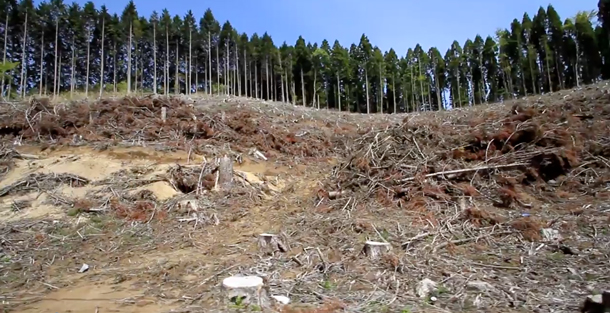
The UN report says land use change is the number one driver of biodiversity loss today. (Photo: IPBES)
CURWOOD: Well, so what should governments be doing? And what about civil society?
WATSON: The public, once they realize that biodiversity loss is not simply an environmental issue, is a social, economic, and development issue, they should be putting pressure on governments and on the private sector. We want a sustainable future, so governments should put in place appropriate energy policies to stimulate a transition to a low-carbon economy, getting rid of fossil fuels and using renewable energy, putting policies in place. So, we're actually more effective in the way we use our energy, stimulate mass transportation, so we don't all have to use an individual car, we do have mass transportation.
Also, put in place policies that are going to help the farmer become more sustainable. So, there's a lot of things. Government is in charge of largely stimulating policy, educating the public about these issues. Private sector in the long-term needs to be sustainable, and most private sector either need nature to be profitable or they put a footprint on nature. So, the private sector needs to take both the biodiversity issue and the climate change issue very seriously.
CURWOOD: Robert Watson, what gives you hope?
WATSON: Well, I suppose what gives me hope is the fact that over the last, you know, four, five, six years, governments have actually done three things that's very important, but in biodiversity, they have the so-called Aichi targets. They have 20 targets for how to protect biodiversity. We've got the Paris Agreement that was negotiated recently that says we should try and limit the change in the Earth's climate to no more than two degrees Celsius and hopefully 1.5, and the world agreed on 17 sustainable development goals, that go from energy security, water security, gender equality, leave nobody behind. So, I think there is a recognition of the importance of environment and development, but the actions to date are inadequate.
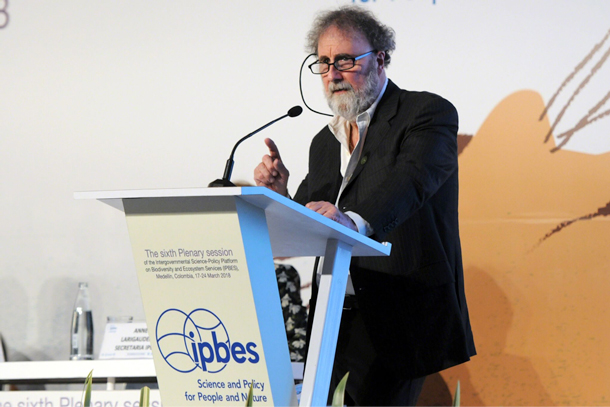
IPBES Chair Sir Robert Watson. (Photo: IISD/ENB, Natalia Mroz)
Governments and the private sector have to be much more sustainable. The pledges under the Paris Agreement are not adequate to meet the two-degree target, they have to be doubled and redoubled. We need to do a much better job of managing our forests, a much better job of managing our agriculture. So, there's a good realization of what is needed, but we're falling short of implementation at the moment. But as our reports show, we can do much better with the current knowledge, we can use technologies better, we can develop policies, we can have behavior change, so there is at least a recognition of the problem; we now have to implement.
CURWOOD: Robert Watson is chair of the Intergovernmental Science-Policy Platform on Biodiversity and Ecosystem Services. Sir Robert, thanks so much for taking the time with us today.
WATSON: And thank you for allowing me to talk with you.
Related links:
- IPBES: Science-Policy Platform on Biodiversity and Ecosystem Services
- IPBES: Biodiversity and Nature’s Contributions Continue Dangerous Decline, Scientists Warn
Nature and the Beat

A Beast Box Orangutan and a Bornean Orangutan. (Image: Russell Watkins/Shutterstock and Beast Box)
[CALLS OF A BORNEO GIBBON]
CURWOOD: The howling call of a gibbon can travel up to two miles across the dense rainforests of Borneo. Many animals make some sort of sound to find a mate, warn of predators, or claim and defend their territory. And now their sounds are being used to create music. Living on Earth’s Bobby Bascomb has our story.
[SFX KATYDID]
BASCOMB: For many us, the staccato notes of a katydid might conjure up memories of a warm summer night, but for Ben Mirin a katydid’s chirp is music.
MIRIN: I hear music in everything.
BASCOMB: Ben calls himself a Wildlife DJ. He travels the world as a National Geographic explorer to record animal sounds. And with help from the Cornell Lab of Ornithology, Ben created a website called Beast Box where users can layer animal sounds over a beat to create their own compositions.
MIRIN: I’m just a messenger for the intricately tuned voices of the natural world. And the fact that nature is always singing is really exciting to me and I hope can create similar excitement and joy in others.
BASCOMB: To make a song, users open the website and then choose one of seven beat tracks that Mirin created himself. You can choose – say, Great Barrier Reef beat…
[GREAT BARRIER REEF BEAT]
BASCOMB: Or Sonoran Desert Beat…
[SONORAN DESERT BEAT]

A Beast Box Cicada. (Image: Beast Box)
BASCOMB: Then select an animal sound, there are 30 of them. You can add as many as five at a time to create a song. So, let’s say you choose a coyote….
[CALLS OF COYOTE IN CLEAR OVER BEAT]
BASCOMB: Then an eastern whip-poor-will …
[MUSIC ADDING WHIP-POOR-WILL]
BASCOMB: A parrot fish …
[MUSIC ADDING PARROT FISH]
BASCOMB: A Hadada Ibis …
[MUSIC WITH ADDED IBIS OVER BEAT]
BASCOMB: And lastly a Blue Wildebeest.
[MUSIC WITH ADDED WILDEBEEST OVER BEAT]
BASCOMB: Put them all together and your song is complete. On the website there’s a paragraph description of each animal and an explanation of their habitat. Each time a user chooses an animal musician, a graphic of that creature pops up on the screen and dances to the beat. For instance, there’s an orangutan in a red leather jacket and matching sunglasses.
[CALLS OF ORANGUTAN WITH BEAT BACKING]
BASCOMB: And a tropical Boubou wears a gold chain and a red cap.
[CALLS OF BOUBOU WITH BEATS]
BASCOMB: Mirin hopes beast box will be fun for anyone but the graphics and the genre of music are geared towards kids like 12 year-old Orion Brown. He says he likes playing with the website.

A Bornean Gibbon. (Image: Beast Box)
BROWN: I think it’s pretty cool. It’s a way to get a good education but also have some fun.
BASCOMB: For an additional challenge, users can try to put all of the animals from the same ecosystem together with the beat designed for that environment – it’s called Beast Mode. Orion chooses the Madagascar Rainforest.
[BEATS OF MADAGASCAR RAINFOREST]
BROWN: The first animal in that ecosystem is the Indri.
BASCOMB: Neither of us know what an Indri is. So Orion reads the description – turns out they’re lemurs.
BROWN: A small group of Indri wake up in the tree tops and begin their morning shout outs. Indri are large for lemurs with booming voices amplified by enlarged throat pouches.
[INDRI CALLS]
BASCOMB: Alright, what’s next in the Madagascar rainforest?
BROWN: The next one is the Lesser Vassa Parrot.
[PARROT CALLS ADDED]

A Blue Wildebeest. (Image: Beast Box)
BASCOMB: He finishes up with the Madagascar Long Eared Owl, the Red Fronted Coua, and the Souimanga Sunbird.
[“BEAST MODE”]
BASCOMB: So what do you think of the song you made?
BROWN: I think when you mash them up with all the ecosystems together, it sounds better, almost like it’s sort of made for the beat.
BASCOMB: So, you mean when you have all of the same ecosystem, like all of the desert or the rainforest or so together?
BROWN: Yeah.
BASCOMB: Do you think that maybe they evolved and they lived together in the same forest and making music together it comes kind of naturally? What do you think of that idea?
ORION: I think that would be a possibility and if so that would be super cool.
BASCOMB: Ben Mirin says Orion is on to something, thinking that the different animal voices complement each other.
MIRIN: Yeah, I would agree with his observation. Animal voices have evolved over millions of years to occupy different acoustic niches in an ecosystem so they don’t compete with one another.
BASCOMB: Making yourself heard is critical to surviving in nature. That’s how whales find mates across the ocean and coyotes defend their territory in the desert. Animals living in the same environment are already tuned to work well together so everyone can be heard and Mirin is excited about tapping into that existing symphony of sounds.
MIRIN: As a producer that means my instruments are already mixed. So instead of being a solo musician I get to be a messenger for the finely tuned orchestras of the natural world.
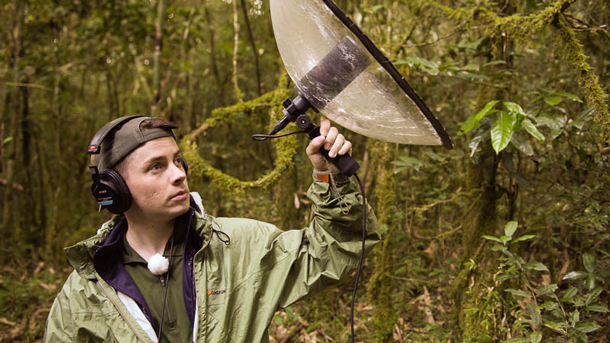
National Geographic Explorer and wildlife DJ Ben Mirin. (Photo: Drew Fulton)
BASCOMB: Mirin says what he wants is for Beast Box to help people learn about nature and create a connection with the natural world.
MIRIN: At the end of the day, understanding and connecting with nature is critical to falling in love with it and we can’t save what we don’t love. So, I would hope that this opens a pathway for you to find your own sense of connection and love for nature so that you can be inspired to protect it, because this is a collective future we all share.
BASCOMB: Ben Mirin plans to continue sharing his recordings to foster that understanding and connection with nature. He recently returned from a trip to the Galapagos and is on his way to the Philippines next, then Honduras. So, an ecosystem from those regions could become a future beast box symphony. For Living on Earth, I’m Bobby Bascomb.
[MADAGASCAR RAINFOREST SYMPHONY]
CURWOOD: And there’s much more about Ben Mirin and his Beast Box at our website, loe dot org.
Related links:
- Beast Box
- Cornell Lab of Ornithology
- About Ben Mirin
[MUSIC: Natraj, “Ava De Se” on The Goat Also Gallops, West African Traditional/transcribed David Locke, Dorian Discovery]
CURWOOD: Living on Earth is produced by the World Media Foundation. Our crew includes Naomi Arenberg, Bobby Bascomb, Savannah Christiansen, Jenni Doering, Jaime Kaiser, Hannah Loss, Don Lyman, Helen Palmer, Aynsley O’Neill, Adelaide Chen, and Jolanda Omari. And we bid good speed and goodbye to Noble Ingram.
Tom Tiger engineered our show, with help from Jake Rego. Alison Lirish Dean composed our themes. You can hear us anytime at L-O-E dot org – and like us, please, on our Facebook page – PRI’s Living on Earth. And we tweet from @livingonearth. I’m Steve Curwood. Thanks for listening!
ANNOUNCER1: Funding for Living on Earth comes from you, our listeners, and from the University of Massachusetts, Boston, in association with its School for the Environment, developing the next generation of environmental leaders. And from the Grantham Foundation for the protection of the environment, supporting strategic communications and collaboration in solving the world’s most pressing environmental problems. Support also comes from the Energy Foundation, serving the public interest by helping to build a strong, clean, energy economy, from Carl and Judy Ferenbach of Boston, Massachusetts and from SolarCity, America’s solar power provider. SolarCity is dedicated to revolutionizing the way energy is delivered by giving customers a renewable alternative to fossil fuels. Information at 888-997-1703. That’s 888-997-1703.
ANNOUNCER 2: This is PRI, Public Radio International.
Living on Earth wants to hear from you!
Living on Earth
62 Calef Highway, Suite 212
Lee, NH 03861
Telephone: 617-287-4121
E-mail: comments@loe.org
Newsletter [Click here]
Donate to Living on Earth!
Living on Earth is an independent media program and relies entirely on contributions from listeners and institutions supporting public service. Please donate now to preserve an independent environmental voice.
NewsletterLiving on Earth offers a weekly delivery of the show's rundown to your mailbox. Sign up for our newsletter today!
 Sailors For The Sea: Be the change you want to sea.
Sailors For The Sea: Be the change you want to sea.
 The Grantham Foundation for the Protection of the Environment: Committed to protecting and improving the health of the global environment.
The Grantham Foundation for the Protection of the Environment: Committed to protecting and improving the health of the global environment.
 Contribute to Living on Earth and receive, as our gift to you, an archival print of one of Mark Seth Lender's extraordinary wildlife photographs. Follow the link to see Mark's current collection of photographs.
Contribute to Living on Earth and receive, as our gift to you, an archival print of one of Mark Seth Lender's extraordinary wildlife photographs. Follow the link to see Mark's current collection of photographs.
 Buy a signed copy of Mark Seth Lender's book Smeagull the Seagull & support Living on Earth
Buy a signed copy of Mark Seth Lender's book Smeagull the Seagull & support Living on Earth

